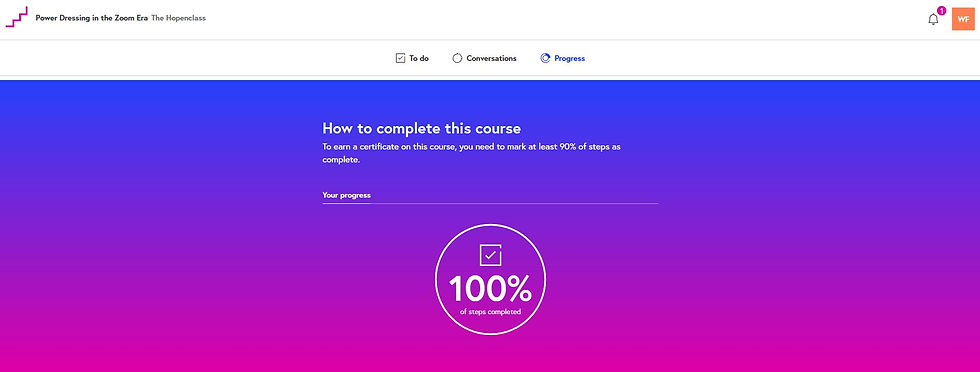Lights, camera, zoom! - Dressing in the online era
- Wardah
- Apr 11, 2022
- 4 min read
Updated: Apr 29, 2022
I have always believed that clothes are powerful visual representations of poise and personality. The clothes I wear can make me feel more competent and ready to tackle daily challenges and opportunities.
I didn’t know much about the term 'power dressing' until I took on the short course titles 'Power dressing in the zoom era'. It was a topic that I was very much interested in given the change in the nature of work and how at any given time, the 'zoom impression' is all people get of me. During video calls, my camera projects me to the audience in a landscape mode. More than 70% of the video frame is background space similar to a mug shot. I wanted to learn how to successfully go beyond that zoom impression and truly connect with my audience. I found out that one such way is through my appearance more specifically my attire.
The English language term “Power Dressing” originated in the 1970’s, as the outfit and silhouette that enables someone to own the space and feel empowered.

To me, I learned that this sort of attire is what lets me say 'I am here, hear me speak, without saying a word.' It communicates professionalism, knowledge, and confidence. It extends from the body to elevate the frame to build an unspoken aura that lets me charm the room and make a great first impression.
But this simplicity behind choosing attire has changed. The zoom era bamboozled all of us into rethinking our fashion choices. Before the onset of COVID-19, I spent many nights laying out my outfit prior to the next workday to guarantee that I had on the ideal outfit when I waltzed in. My fondness for fashion, and having the tendency to express that through what I wear, demonstrated to be problematic during these changes.

Now, whenever I have a meeting from home, I tend to not put in the same effort, just hide away the PJs with a decent looking semi-unwrinkled blazer and call it a day. But I found out that, not dressing up everyday for work actually made me less productive.
It turns out there’s actual science to back up that feeling. Researchers studying links between clothes, brain activity, and productivity have long found that dressing up for work can improve your performance. The reason for this is simple, when dressing up, we are mentally preparing ourselves for the day ahead, the clients we will meet, the emails we will reply, and the meetings with the boss that we will dread. All this signals our brain and body to ‘turn on’ the confidence that you would mostly 'turn off' at home.
Work is something people do, it is no longer just a place.
Speaking without words
According to Amy Cuddy, effective communication in co-working environments relies heavily on nonverbal cues. I already knew that facial expressions, gestures, posture, eye contact, and lack/absence thereof all played a part in speaking the unspoken but I didn’t realize that overall appearance is equally important.
We can communicate many things with the way we dress and present ourselves on camera: moods, intentions, aura/vibes, allegiances and stances, confidence and expertise, etc. And given that we have a much smaller area to do it, the art of 'zoom' must be effective.
What to wear for my next important zoom meeting?
Now that I figured out that overall appearance plays a key role in asserting your presence during a virtual call, I needed to figure out, the age-old question that every female asks most mornings, 'but what do I wear'?
Hair we go:
Appearance starts with grooming and since I cover my head, doesn’t mean that hair shouldn’t be a consideration. by cleanly tucking it in to ensure no strays and picking out a hijab that doesn't wrinkle with the slightest movement.
Accessorize, but don't overdo
Award-winning hairstylist Charlotte Mensah, says that accessories add a pop of expression to one’s overall look. For me, that’s a simple pendant style necklace and my tried and tested pair of glasses with an anti-glare coating, both ensuring no unnecessary reflection occurs. But I shouldn’t be afraid to try different styles of frames from cat-eye to bold oval frames. This is where I can play around with and try different styles.
Clothes = Intention
3 basic steps must be followed:
Keep things crisp and clean (wrinkles are visible on camera too)
Keep colors simple (solid, neutral, avoid neon)
Dress it up (a little spice is always encouraged)
In order to not become a talking point, the idea is to appear confident yet professional while having a business meeting, the same applies on zoom with a few more considerations like color, if the background is blue, wearing a similar shade blazer will wash me out, I need to be able to wear contrasting colors that harmonize to avoid the call participants from straining their eyes.
Classic cuts like a solid-colored button-down or blouse never goes out of fashion and are pieces that never fail but while trying to create an impression of professionalism, I can also try to dress up a simple and classic look by wearing a bright-colored lipstick or adding a broach.

Final takeaway:
Just because the nature of work has changed doesn't mean that I need to stop enjoying clothes. With these simple but effective steps that I learned from this course, I can still dress myself how I want to but have my skills talk before my attire. After all, confidence is inspiring even when perceived virtually. And the clothes that I wear can give me that confidence.










Comments